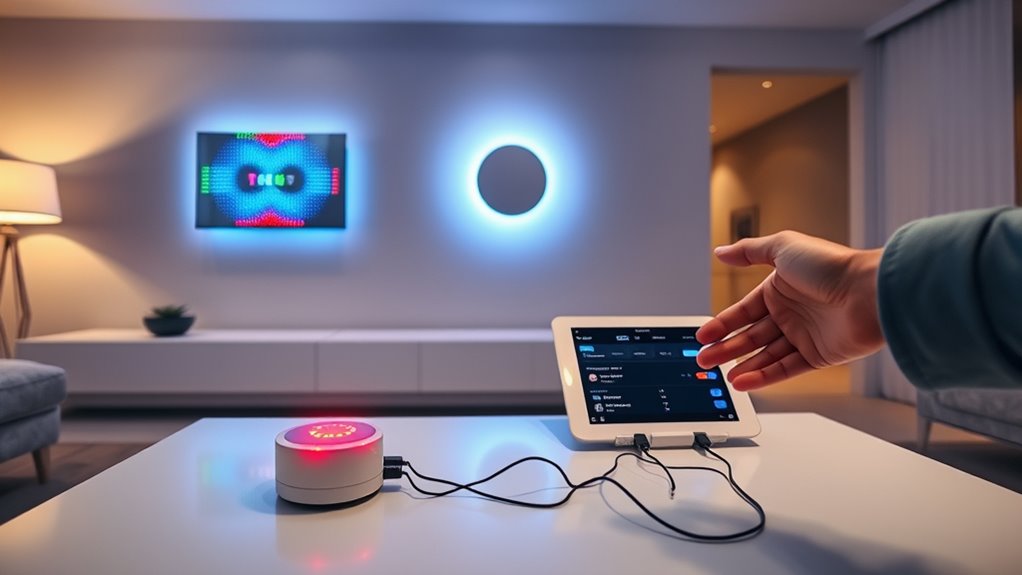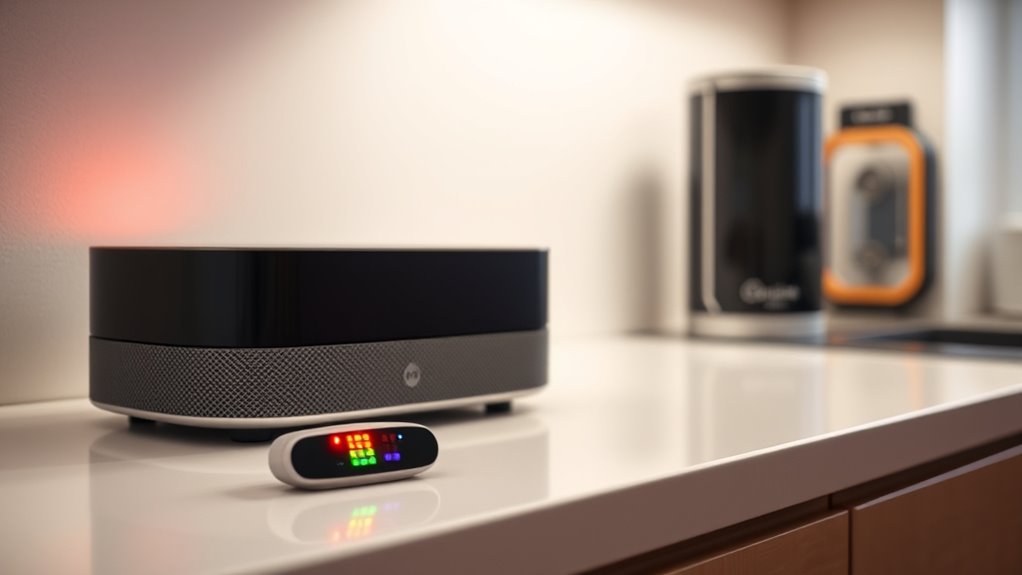To integrate deaf alerts into your smart home hub, start by evaluating your current devices for compatibility and open API support. Choose reliable visual or vibrational alert systems suited to your needs, and connect them to your hub following manufacturer instructions. Customize notification settings for different emergencies, ensuring visuals are high-contrast and alerts are easy to recognize. Regularly test and maintain your system to keep it reliable. Continue exploring to discover detailed steps for a safe, inclusive home environment.
Key Takeaways
- Verify smart home hub compatibility with visual and vibrational alert devices supporting open APIs and firmware updates.
- Connect and configure alert devices using the hub’s platform, customizing visual patterns, brightness, and vibration settings.
- Incorporate high-contrast visual signals like flashing lights or LED strips, tailored to different emergency scenarios.
- Test alert activation thoroughly, ensuring reliable performance and proper placement for maximum visibility and accessibility.
- Provide user training on alert recognition, customization, and troubleshooting to maintain an inclusive and responsive environment.
Assessing Compatibility of Your Smart Home Devices

Before integrating deaf alerts into your smart home hub, you need to make sure your devices are compatible. Device compatibility is essential for seamless system integration, ensuring all components work together smoothly. Check your smart home devices’ specifications to see if they support alert systems or have open APIs that allow third-party integrations. Some devices may require firmware updates or specific protocols to function correctly with deaf alert systems. Make a list of your current devices and review their compatibility features. If certain devices aren’t compatible, consider replacing or upgrading them to ensure your deaf alerts work reliably. Proper assessment of device compatibility prevents future issues and guarantees that your system integration is effective and responsive. Additionally, understanding the compatibility standards can help you make informed decisions about which devices to select or upgrade.
Choosing Effective Deaf Alert Systems

Once you’ve confirmed your smart home devices are compatible, the next step is selecting the most effective deaf alert systems. Focus on visual alert effectiveness; choose devices that provide clear, noticeable signals like flashing lights or screen notifications. Consider the environment—bright lights may be less effective in well-lit rooms, so opt for high-contrast visuals. Cost considerations are also important; some alert systems are affordable, while others offer advanced features at a higher price. Balance your needs with your budget, ensuring the system you select reliably signals important events without overspending. Evaluate options based on their visibility, ease of use, and integration capabilities. Additionally, understanding the vibrational energy associated with your environment can help you select alert systems that align with your vibrational preferences. A well-chosen deaf alert system enhances safety and awareness, making your smart home truly inclusive.
Connecting Alerts to Your Smart Home Hub

Connecting your deaf alert systems to your smart home hub is a crucial step in creating an integrated and responsive environment. First, guarantee your alert device is compatible with your hub’s platform. Use voice recognition features to set up commands that trigger alerts or notifications. This allows the system to understand specific sounds or phrases, making alerts more effective. High-quality audio detection is essential for ensuring that alerts are recognized accurately and promptly. During setup, you’ll need to perform user training, where you teach the system to recognize your voice and specific alerts. Proper training helps reduce false alarms and improves responsiveness. Once connected, test the system thoroughly to confirm alerts activate correctly through voice recognition. This setup ensures that your deaf alert system works seamlessly within your smart home, providing reliable notifications tailored to your needs.
Configuring Visual Notification Settings

You can personalize your visual alerts by customizing flash patterns to catch your attention effectively. Adjusting brightness levels guarantees alerts are visible without being overwhelming. These settings help you create a notification system that’s both noticeable and comfortable for your environment. Incorporating vetted options can ensure your alerts remain reliable and safe.
Customizing Flash Patterns
Customizing flash patterns allows you to tailor visual alerts to better suit your preferences and needs. By adjusting the visual pattern selection, you can create distinct flashing light customization that makes alerts more noticeable and personalized. Choose from options like slow pulses, rapid flashes, or alternating colors to match your environment and alert type. Here’s a quick guide:
| Pattern Name | Description | Best Use Case |
|---|---|---|
| Steady Blink | Consistent flashing | General alerts |
| Rapid Flash | Fast, intense flashes | Urgent notifications |
| Alternating Colors | Switches colors with each flash | Visual distinction |
| Slow Pulse | Gentle, slow pulses | Relaxed notifications |
| Custom Pattern | User-defined sequences | Personalized alerts |
Experiment with these options to enhance your deaf alert experience through flashing light customization and understand how visual notification settings can be optimized for your environment.
Adjusting Brightness Levels
Adjusting brightness levels is essential for guaranteeing that visual alerts are effective without being overwhelming. Brightness adjustment helps you find the right balance so alerts are noticeable but not glaring. Use the dimming controls on your smart home hub or connected devices to fine-tune the light intensity. Start by setting the brightness to a comfortable level that catches your attention without causing discomfort. If your hub offers manual or automatic dimming options, experiment with both to see what works best for your environment. Remember, consistent brightness levels improve recognition and reduce alert fatigue. Facilitating collaboration among global teams can also be beneficial when troubleshooting or optimizing alert settings with remote support. Adjusting these settings ensures that deaf alerts are both visible and unobtrusive, seamlessly integrating into your daily routine. Proper brightness adjustment enhances the overall effectiveness of your visual notification system.
Setting Up Vibrational Alerts for Critical Events

To guarantee essential alerts are immediately noticeable, vibrational alerts can be a highly effective addition to your smart home hub. By enabling vibrational feedback, you ensure that important notifications grab your attention even when you’re not looking at the screen. Start by accessing your device’s alert settings, then activate vibrational feedback for specific events like smoke detection or security breaches. Use alert customization options to tailor the vibration patterns—such as increasing intensity or duration—to suit your preferences. This way, you’ll receive distinct, tactile signals for different alerts, reducing the chance of missing crucial events. Proper setup ensures that critical notifications are both noticeable and personalized, enhancing your home’s safety and your peace of mind. Incorporating vital health benefits of sensory alerts can further optimize your alert system’s effectiveness.
Integrating External Notification Devices

Integrating external notification devices with your smart home hub expands your alert options beyond the built-in features, guaranteeing you never miss critical updates. Focus on visual signal design to create clear, noticeable alerts that suit your environment. Proper alert device placement is key—position devices where you’ll easily see them during daily activities, such as near entrances or common areas. Consider using flashing lights, LED strips, or specialized visual alarms that complement your home’s layout. Ensure signals are bright enough to catch your attention without causing discomfort. Test different placements and designs to find the most effective setup. Incorporating visual signaling solutions can further enhance your home’s accessibility and ensure vital alerts reach you promptly.
Customizing Alerts for Different Types of Emergencies

Once you’ve set up external notification devices, tailoring alerts to different emergencies guarantees you respond appropriately. To do this effectively, focus on customizing your visual alert design and following emergency alert protocols. A well-designed alert system can also incorporate visual symbols that are universally understood, reducing response time during crises. Here are three key steps:
- Assign specific colors or patterns to various emergencies, making visual alerts instantly recognizable.
- Adjust alert intensity and duration based on the severity of the situation, ensuring you notice urgent alerts without overwhelming you.
- Incorporate clear, concise visual symbols aligned with emergency alert protocols to minimize confusion during critical moments.
Testing and Troubleshooting Your Deaf Alert System

Before relying on your deaf alert system, it’s vital to thoroughly test it to guarantee everything functions properly. Start by triggering each alert type to ensure they activate correctly across your smart home hub. Check the battery life regularly, especially before emergencies, to prevent power issues. If alerts don’t work as expected, troubleshoot connections or settings within your system. Additionally, proper user training is essential—make sure everyone knows how to test alerts and respond appropriately. Confirm that alerts are loud enough or visually noticeable, and verify that devices respond promptly. Regular testing helps identify problems early, ensuring your deaf alert system remains reliable. Remember, consistent checks and clear user training are key to effective emergency preparedness. Incorporating sound design principles can also enhance alert audibility and clarity, making sure alerts effectively grab attention when needed.
Maintaining and Updating Your Accessibility Features

Regular maintenance and timely updates are essential to keep your accessibility features functioning effectively. Staying on top of updates guarantees your voice recognition remains accurate and reliable, and that alerts are delivered promptly. To maintain your system:
Regular maintenance and updates ensure your accessibility features stay reliable and effective.
- Regularly check for firmware and software updates to improve performance and security.
- Refresh your user training to ensure everyone understands how to activate and customize deaf alerts.
- Test voice recognition accuracy periodically, especially after updates, to identify and correct any issues early.
Keeping your system current helps prevent glitches and ensures your alerts are accessible when needed. Consistent upkeep guarantees your smart home remains truly inclusive and responsive to your needs.
Tips for Creating an Inclusive Smart Home Environment

Keeping your accessibility features updated is a great start, but creating an inclusive smart home environment requires intentional design choices. Incorporate soundproofing strategies to minimize noise disturbances and ensure a comfortable space for everyone. Use physical barriers, acoustic panels, or heavy curtains to enhance sound insulation, supporting both deaf and hearing household members. Additionally, leverage deaf community resources to learn best practices and access specialized tools. Engage with local organizations or online forums to stay informed about inclusive design ideas. Prioritizing clear visual alerts, accessible interfaces, and thoughtful soundproofing creates a welcoming environment. These steps not only improve communication but also foster a sense of belonging for all household members. Inclusivity begins with deliberate choices that respect diverse needs.
Frequently Asked Questions
Can Deaf Alert Systems Be Integrated With Voice-Controlled Smart Home Devices?
You can definitely integrate deaf alert systems with voice-controlled smart home devices. Most systems support visual notifications, so you’ll receive alerts through flashing lights or on-screen messages. To do this, verify the device compatibility first—many modern hubs and devices are designed to work with deaf alert systems. Once compatible, setting up visual alerts ensures you stay informed, even if you’re not using audio-based notifications.
What Are the Best Practices for Battery Life in Vibrational Alert Devices?
To maximize battery life in vibrational alert devices, focus on battery optimization and power management. You should regularly update device firmware for efficiency, disable unnecessary features, and use power-saving modes when available. Reduce alert frequency if possible, and keep devices away from heat sources. Properly managing these aspects helps extend battery life, ensuring your vibrational alerts stay reliable without frequent recharging or battery replacements.
How Do I Ensure My Alerts Are Accessible to Users With Varying Degrees of Deafness?
You might think alerts are universal, but they aren’t. To guarantee accessibility for users with varying deafness levels, consider visual cues like flashing lights and easy-to-understand icons, enhancing visual impairment and cognitive accessibility. Use multiple alert types simultaneously, so everyone’s covered. Remember, what’s obvious to one might be missed by another—so test your system with real users, and keep all alert options clear, simple, and inclusive.
Are There Options for Integrating Deaf Alerts With Security or Surveillance Systems?
Yes, you can integrate deaf alerts with security or surveillance systems by using visual indicator integration, like flashing lights or screen alerts, to signal emergencies. Make sure your system follows emergency notification protocols, ensuring alerts are immediate and clear. Check if your security hardware supports visual alerts, and configure your smart hub to trigger these visual cues during alarms or security breaches, keeping you informed visually at all times.
How Can I Customize Alerts for Multiple Users With Different Accessibility Needs?
Imagine tailoring your smart home to truly understand everyone’s unique preferences. To do this, explore the personalization options available within your system. You can set user-specific settings for alerts, ensuring each person receives notifications suited to their needs—visual cues, vibrations, or custom sounds. By customizing alerts for multiple users, you create a more inclusive environment where everyone stays informed comfortably and effortlessly.
Conclusion
By following these steps, you can create a smart home that truly keeps everyone safe and aware. Don’t you want a space where you’re always in the know, no matter how you communicate best? With the right setup, your home becomes more inclusive and responsive to your needs. So, why wait to make your environment safer and more accessible today? Take action now and enjoy the peace of mind that comes with an inclusive smart home.











